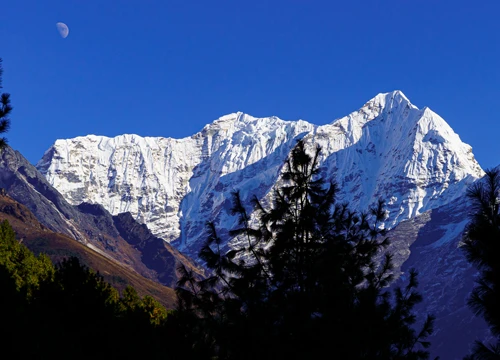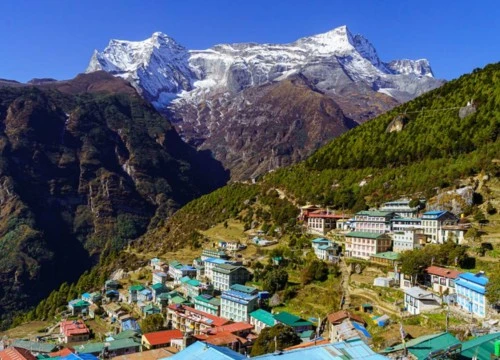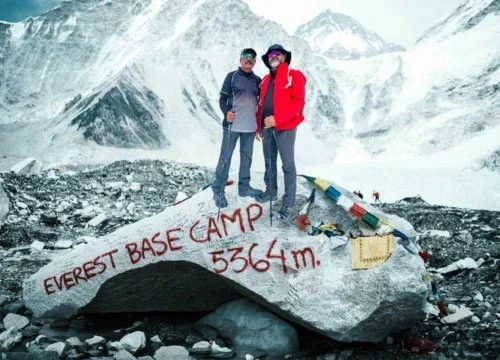Permits for Everest Three Pass Trek
To undertake the Everest Three Pass Trek, trekkers need the following permits:
TIMS (Trekkers’ Information Management System) Card– Required for all trekkers in the Everest region.
Sagarmatha National Park Entry Permit – Mandatory for trekking within the Sagarmatha National Park area.
Gokyo/Renjo La Area Permit (if applicable) – Some routes, especially via Gokyo and Renjo La, may require additional local permits.
Permits can be obtained in Kathmandu before the trek or at Lukla check post in case of emergencies. It’s recommended to arrange permits in advance to ensure a smooth trekking experience.
What is the best time or season for Everest three high pass trek?
The High Pass Everest Trek is a challenging trekking experience in the Solukhumbu region. The pass is through three high mountain passes which are Kongma la pass, Cho la pass and Renjo La Pass. This trek can be done in various time or season but each period has its own difficulty. The best recommended season for the three pass trek is spring and autumn.
Spring is considered one of the most popular times for embarking in the Everest region. The spring season in Nepal fall between months of March to May. The weather in the region is relatively stable with average temperature 15°C (-9°F) which makes the trekking experience relatively easier. The rhododendron forest and other uphill vegetation feel lively. This addition of the vibrant colors adds extra beauty to the might Everest region. The trails are more suitable with fewer crowds as compared to peak season which is autumn. The longer days in spring adds more to the daylight hours enabling explorers with longer travel distance.
Autumn is another excellent time to undertake the high pass trek in Everest. The autumn season in Nepal fall between months of September to November. The weather in the region is clear and stable with mild temperatures (-5°C to 10°C/-20°F to -12°F) which offer a comfortable trekking season. The mountains, landscapes and architectures along the route sparkle and blend with the natural surroundings. Traditional Sherpa villages, White colored Monasteries surrounded by prayer wheels and fluttering prayer flags make the Everest three pass route a spiritual and mystical destination.
The visibility is excellent with unobstructed view of mountains like Everest, Lhotse, Ama Dablam, Thamserku and many more which offers a worth photo.Despite spring and autumn the Holiday Planner Nepal roadmap to Everest Three pass can be commenced in winter. However it is really difficult and risky The temperature will not be a friend, due to bone chilling nights and freezing morning. There can be heavy snowfall and avalanches and foggy visibility. All these conditions are life threatening and for the most unsuitable. We at Holiday tours Nepal do not recommend Everest Three pass route at this particular season. However, for hardcore adrenaline individuals who want to challenge the extreme situation it can be arranged.
Overall, with the right gear, knowledge, and local guides from Holiday Planner Nepal, the journey is doable even in extreme cold. Additionally consult with Holiday Tours Nepal for further understanding the conditions and risks before attempting Everest Three High Pass trek in winter.
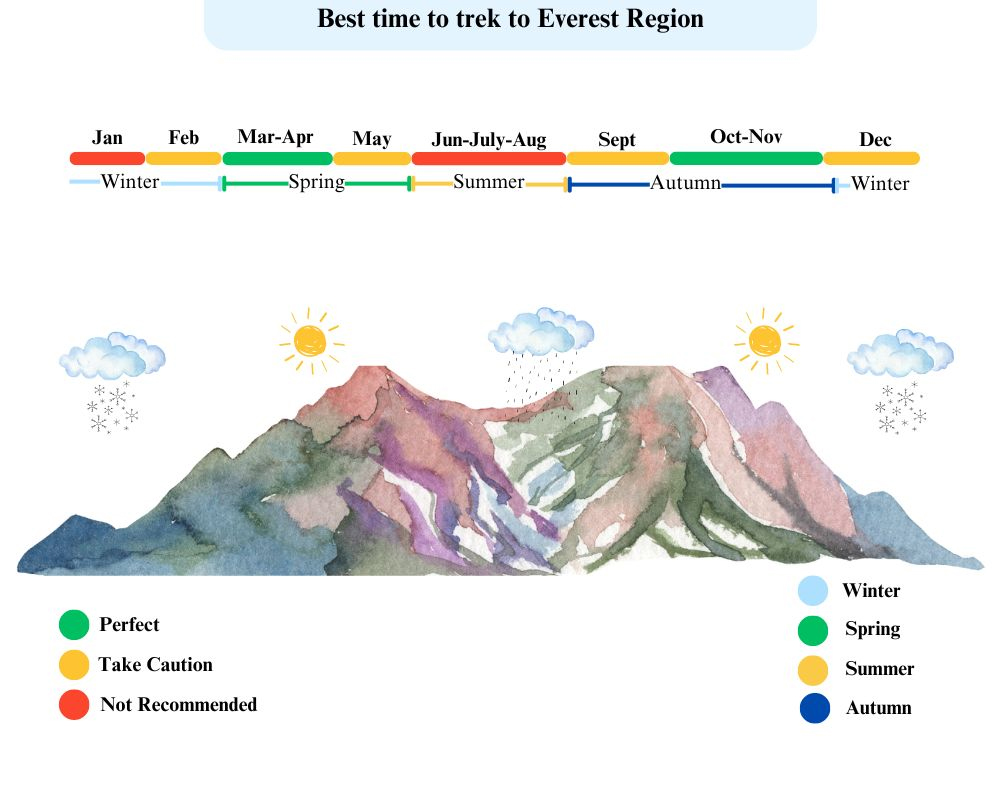
Physical fitness level for Everest High Pass Trek
Everest Three Pass Trek is a difficult trekking route. This is not a beginner’s trek and embarking on this journey requires 3-4 prior trekking experience. As the three pass trek involves walking on frozen glaciers, steep rocky trails and climbing experience individual should have good stamina and endurance.
However it necessarily doesn’t require hardcore trekking experience or exceptional physical ability. The variable destination and high altitude experience can make the journey very easy. If an individual has a habit of regular cardiovascular exercises like running, cycling and hiking then they can endure the trek. Similarly, previous high altitude trekking can help to cope with this trek as the trekking zone is often 5000 meters/16400 feet.Proper mental preparation, balance and flexibility needs to be maintained as the route is mostly steep climb through rough terrain. Be sure to keep knowledge of any unforeseen circumstances which can help to tackle problems during the trek.
Similarly, individuals with serious medical conditions such as heart and lung disease or chronic illnesses should also refrain from attempting this trek. It is advisable to omit this journey and attempt for easier trekking destination as the consequences can be severe.

Accommodation facilities
Proper trekking experience depends upon several factors and one of the crucial is the accommodation. The type of accommodation experience along the route directly affects the physical fitness level and indirectly affects the mentality of the trekkers. Proper accommodation services and a good night sleep can boost the trekking for the following day. There are various options for choosing a place to stay from camping, teahouses and lodges to even luxury houses. However it is important to know that these accommodations are available in some sections of the route and the facilities might decrease as trekkers ascend to high altitude. Some common types of accommodation are:
- Teahouse or Lodges: These are the most common and convenient accommodation options for travellers. Teahouses are small guesthouses which offer basic comfortable rooms with beds and blankets. The bathroom in this accommodation place is mostly shared.
- Camping: It can be suitable accommodation option for trekkers as most of the places in the area are remote and underdeveloped. Trekkers, guides and porters carry tents, sleeping bags and other camping gear. This allows a freedom and thrilling experience in the nature under the sky however it requires a more logistic preparation which can be handled by Holiday Tours Nepal.
- Luxury Houses: Luxury houses are present only in some part of the route. Individuals can have cozy and prestigious amenities which can include comfortable rooms with attached bathroom, hot showers and heating system. However, these facilities come with extra cost.
- Guesthouse and Homestay: In particularly more developed areas or area with higher settlements we can find guesthouse and homestays. They are the accommodation where travellers can stay with the local families in their homes. This is a unique opportunity to immerse in the culture of local residents of Khumbu region.
We have the option of providing rooms with electric blankets and attached bathrooms at an additional cost of $400 per person. These types of lodges are not luxurious lodges, but they are comfortable lodges compared to normal and basic lodges and are warm and comfortable. Places like Phakding, Namche, Tengboche, Debouche, and Dingboche offer these facilities. For the last two days at Gorakshep and Lobuche, attached bathrooms have not been available, but electric blankets are available, which work through solar panels. In case the blankets are not working, we provide hot water bags to all the clients and trekkers.
Acclimatization and Communication
Acclimatization, Communication and Electricity are some important factors which needs careful consideration while taking the Everest Three Pass roadmap.
Acclimatization:
In high-altitude activities such as the Three Pass Trekking in theEverest Region, acclimatization is essential. Various high passes must be crossed during the hike, which can tire the body physically. It's critical to take acclimatization pauses and give your body time to adjust to the altitude to prevent altitude mountain sickness and other related health problems.
There are multiple rest days made suitable into the trek to aid in acclimatization. In order to give your body time to acclimate to the altitude, it is recommended to stay hydrated and avoid alcohol and tobacco. Trekking with gradual ascent in order to aid with acclimatization is the best choice. Some hikers also decide to take medicine; nonetheless, it is advisable to speak with a medical practitioner before taking any medication.
Communication:
Holiday Tours Nepal provides each visitor with a Sim card to make communication easier while visiting the country. While Three Pass Trekking, communication can be difficult, particularly in isolated locations with spotty network connectivity. On the other hand, there are numerous ways to remain connected when hiking.
- Mobile Network: There is coverage for mobile networks in certain areas of the hike. On the other hand, the network may be erratic and constrained. It is advised to always have a phone with a strong battery backup and a local SIM card on you.
- Satellite Phones: Several of the lodges and campsites along the trek provide satellite phones for rent. Although they can be pricey, they are more dependable and provide better coverage in isolated locations.
- Internet cafes: A few of the larger cities and villages along the path provide internet cafes. They provide phone services, including international calling and messaging, as well as internet access.
It's crucial to remember that in some places, communication options may be costly and scarce. It is advisable to communicate your itinerary to your trekking companions and loved ones and to keep them informed of your location. In an emergency, having a GPS gadget or personal locating beacon on you can also be helpful.
Electricity and Wi-Fi
For the most part, the trekking path allows you to use cellular service and the internet, with the exception of high mountain crossings. Teahouses along the path frequently have phone or camera charging stations available which they typically charge between $2 and $3. Be advised that certain teahouses may charge an additional fee for wireless internet services. If you like to capture as many memorable moments as you can while out for a stroll you can pay extra charge for camera charging. However, to avoid these potentially costly charges, travellers are advised to carry a small solar charger or a power bank. By doing this, you can benefit from ongoing connectivity without being concerned about cost.
Altitude Sickness during Everest Three Pass Trekking
Altitude sickness is a common problem for individuals who plan to hike theEverest Three pass Trekking Route. This is a common problem in high altitude region of Everest. This can be due to rapid ascent to higher elevations without enough acclimatization is a common cause of AMS (Acute Mountain Sickness). The symptoms can be headache, nausea, dizziness and shortness of breath. However in severe case altitude sickness can lead to pulmonary edema or cerebral edema which can cause a life threatening scenario.
So here are some tips provided by Holiday Planner Nepal to prevent altitude sickness during the Everest Three Pass Trekking.
- Acclimatization: It is an essential procedure to cope with reduced oxygen level at higher elevation. This means individuals will have to take frequent rest days before ascending into higher elevation. This will make the body familiar with the environment which ultimately helps to reduce altitude sickness probability. It is also recommended to gain not more than 300-500 meters elevation per day and take rest in between 3-4 days.
- Hydration: Stay hydrated to prevent dehydration, which can make altitude sickness worse. Steer clear of caffeine and alcohol as they might dehydrate the body.
- Medicine: Eat garlic soup or think about taking medicine to avoid altitude sickness. Before taking any medication, see your doctor, and be sure you are taking the recommended amount.
- Descend: Quickly descend to a lower altitude if you start to exhibit signs of altitude sickness. As soon as your symptoms have subsided, stop climbing.
- Identify Symptoms: If you encounter any of the signs of altitude sickness, let your guide or hiking partner know. Headache, nausea, vertigo, and dyspnea are possible symptoms.
- Fitness: To better handle the physical demands of the trek and lower your chance of altitude sickness, train appropriately prior to the hike. This will increase your endurance and level of fitness.
Is travel insurance necessary?
Anyone intending to hike the Everest Three Pass Trekking route is strongly advised to purchase travel insurance. This kind of insurance can cover a variety of dangers and unforeseen circumstances that may arise while on the hike. When buying travel insurance for the Everest Three Pass Trek, keep the following points in mind:
- Medical coverage: Verify that the policy covers medical costs, which can be expensive at high elevations, including emergency medical care and evacuation.
- Trip cancellation and interruption: Purchase coverage for trip cancellation and interruption to safeguard yourself if unforeseen circumstances, such as illness, injury, or natural disasters, force you to postpone or cancel your vacation.
- Lost or Stolen stuff: Seek out insurance that covers stuff like gear, equipment, and personal effects that are lost or stolen.
- Adventure sports coverage: Verify if the policy includes high-risk activities like trekking and mountaineering, as some do not.
- Emergency assistance: In the event of a medical or other emergency, look for coverage that offers round-the-clock emergency assistance.
- Pre-existing conditions: Verify if the policy covers your pre-existing medical issues or offers a waiver if you have any.
Holiday Tours Nepal Exercise and preparation routine for attempting Everest Three Pass Trek
Week | Focus areas | Activities | Details | Remarks |
Week 1-2 | Building base for the trek | Cardio, strength and flexibility | Cardio: 3-4 days/week: Brisk walking, cycling, or jogging (45-60 minutes)
Strength: 2-3 days/week: Squats, lunges, step-ups, planks (3 sets of 12-15 reps)
Flexibility: Stretching or yoga (20 minutes after each workout) | Helps to build the base that will help for building endurance and stamina. |
Week 3-4 | Strengthening the Legs | Hiking, Strength, Core | Hiking: 2-3 days/week: Hike on an incline or treadmill (1-2 hours). Start carrying a light pack (5-10 lbs.)
Strength: 2-3 days/week: Squats, lunges, step-ups with weight (10-15 lbs.)
Core: Planks, leg raises, Russian twists (3 sets of 20 reps) | Helps to develop strength and make the legs stronger which will help for the hike during the trek. |
Week 5-6 | Increasing Intensity | Endurance, Weight Training, Hiking | Hiking: 2-3 long hikes (3-4 hours) with weight (10-15 lbs.). Focus on incline and rocky terrain
Cardio: Running or cycling for 45-60 minutes (2-3 times/week)
Strength: Weighted squats, lunges, step-ups, core work (3 sets of 12-15 reps each) | Helps to build further endurance |
Week 7 | Endurance & Simulation | Long Hikes, Full Body Strength | Long Hikes: 1-2 long hikes (5-6 hours) with heavy pack (15-20 lbs.), focus on uphill and varied terrain. Include stairs if possible
Strength: Full body exercises (weighted squats, lunges, step-ups, planks)
Core: 3 sets of planks, side planks, mountain climbers | Helps for building endurance for long hikes and helps for stamina. |
Week 8 | Peak Intensity & Recovery | Simulation, Light Cardio | Simulation: 1 long hike (6-7 hours) with a full pack, focus on staying hydrated and fueled
Cardio: Light running or cycling (30-40 minutes)
Recovery: Stretching, yoga, light walking for flexibility and muscle relaxation | Helps for stretching, flexibility and preparation before and after hike |
Week 9 | Breathing training | Nose and mouth breathing patterns. | Box to box breathing, navy breathing, nasal breathing, belly breathing, 4-7-8 breathing, pursed lip breathing, coherent breathing, bhastrika breathing | Helps for breathing in high altitudes |
Tips for trekkers who are trekking in the Himalayas
Tips for female travelers during periods in the mountains
Know your cycle and pack accordingly sanitary pads, period underwear’s, menstrual cups and tampons.
Pack sanitary pads in case sometimes the dates can be up and down and even someone might need in trek in case you don’t use it.
Bring pain relivers like ibuprofen, heat patches, to ease cramps stay hydrated and eat good nutrition food.
- Wear comfortable and food layered clothing’s rest when needed and mind your mood.
Equipment and Gear List
 General
General
- Four-season (-20 degree) sleeping bag (We provide rental sleeping bags available for an additional USD 35)
- Puffy down jacket (We provide rental jackets for an additional USD 35)
- Daypack (25-30 liters recommended) with rain cover
 Upper Body
Upper Body
- Sun hat or cap (We'll provide you with a trekking cap.)
- Warm woolen hat
- Scarf/Neck Buff (highly recommended to get saved from wind and cold)
- Headlamp or mobile torch light for nighttime
- Polarized sunglasses
 Torso
Torso
- Technical fabric base layer thermals are light for warmer months, heavy for colder months
- Technical fabric t-shirts and sleeve sweaters or high-necks
- Waterproof rain jacket
- Windproof jacket for the walk as it gets windy
- Fleece jacket or down jacket
 Lower Body
Lower Body
- Thermals inner
- Hiking pants at least 3
- Comfortable pants for teahouses
- Waterproof, windproof shell
- Hiking shorts
 Hands
Hands
- Woolen gloves for the tea house
- Hard-shell windproof outer gloves for the walk
 Feet
Feet
- Marino Wool or comfortable, warm socks
- Hiking socks
- Liner socks
- Trekking/hiking boots (waterproof recommended)
- Crampons (For passes)
- Casual shoes or sandals that are comfortable for the time in the tea house
- Gaiters (lightweight for rain and snow)
 Undergarments and Inner Wears
Undergarments and Inner Wears
- Technical fabric/quick drying (can be washed during the trek)
- Sports bras (women)
- Sleeping clothes as per the comfortability
 First Aid Kits and Medications
First Aid Kits and Medications
Note: Our guides carry medications, oxygen cans, and first aid kits during the trip. However, personal kits and medications are recommended.)
- Sunscreen SPF- 50+
- Lip balm or Vaseline
- ointment cream
- Cough Syrup and strepsils (recommended for Khumbu Cough)
- Creams and medicines (for any allergies or diseases)
 Other Essentials
Other Essentials
- Passport
- Extra copies of passport-sized photos
- Reusable water bottle
- Toilet paper, small soap, and shampoo
- Water purification tablets or UV water purifier (if you plan to treat water)
- Water bladder for the day bag
- Small towel for personal use
- Pillowcase in case of allergies to new pillows
- High-protein snacks (such as mountain bars or nuts)
- Waterproof/dry bags for carrying essential documents, stuff, frequently used items, and money
- Power bank or extra batteries
- Cameras and mobile phone
- Cards/book
- Pee bottle/ pee funnel for women
- Trekking poles
- Whistle in case your voice is not loud enough to stop or start
- Thermos for hot water during the nighttime
- We give you a free duffel bag, trekking cap, maps, and t-shirt during your pre-trip meeting in Kathmandu. The duffel bag will be used to pack your trekking supplies.
- For every two participants, we assign one porter. The porter will carry the duffel bag, which should weigh around 10 kg/22 lbs., throughout the walk.
- Daypack bag for daily used stuff like cash, documents, papers, a water bottle or bladder, a camera, toiletries, sunscreen, a notebook, clothing, etc. (with a waterproof cover).
- You can store your luggage (on-trekking items) at the hotel in Kathmandu, and we can assist and help.
- Total luggage for the Kathmandu-Lukla flight is (15 kg/33 lbs.), including duffel (10 Kg/22 lbs.) and backpack (5 kg/11 lbs.)
- A down jacket with a hood(cap) to be warm in altitudes above 3,000m.
- We can provide a down jacket for USD 35. In case of loss or damage, you need to pay back the cost of USD 200 per item.
- We can provide a sleeping bag for USD 35. In case of loss or damage, USD 200 per item must be paid.
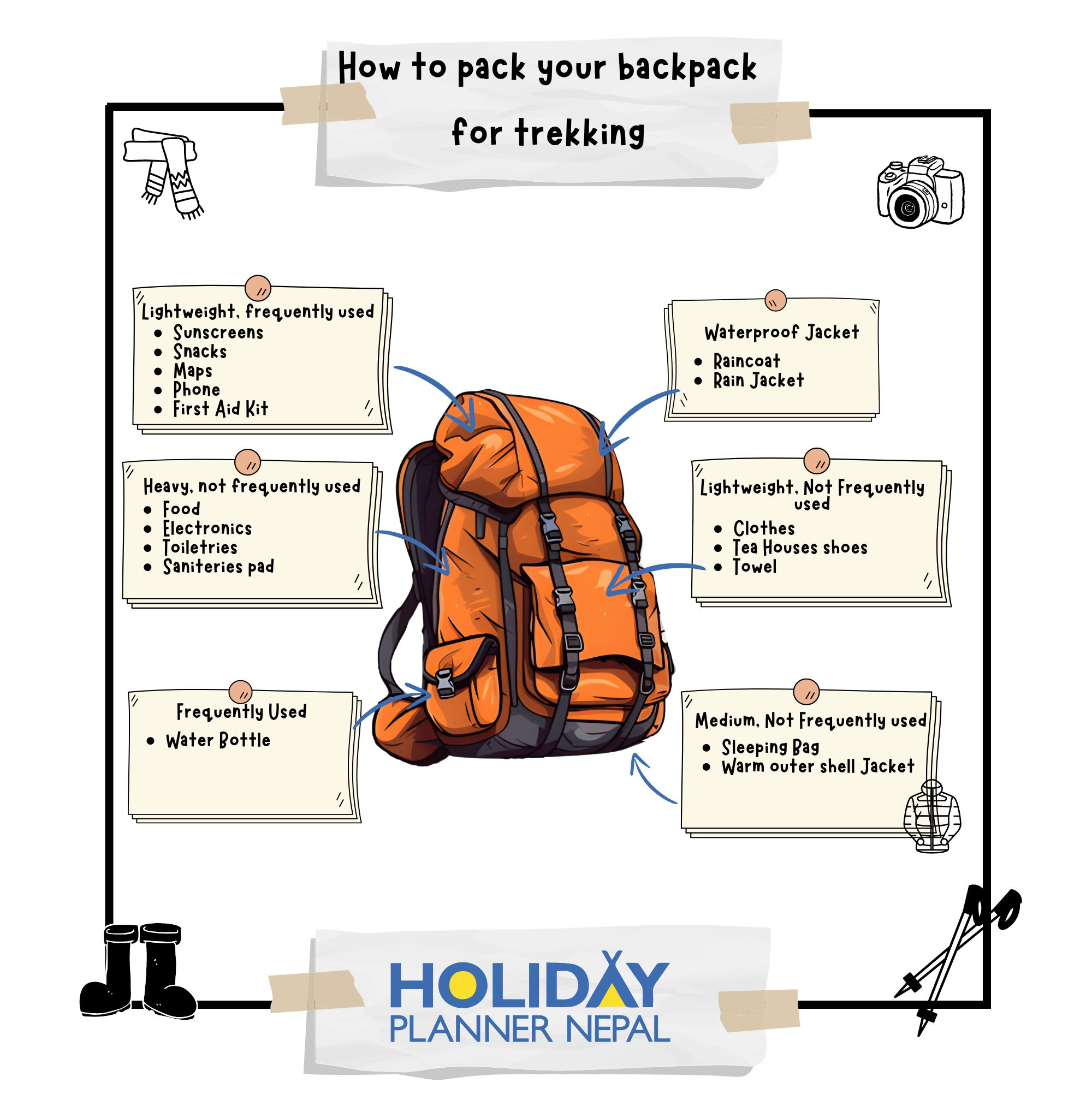
Note: Supplies and gear can be rented or purchased in Kathmandu. Once you are in Nepal, you can buy supplies and gear for hiking if you have spare time. Holiday Planner Nepal representatives will assist you in purchasing the equipment. Thamel a tourist hub, offers a wide range of trekking equipment at affordable prices. Don't wear short clothes inside the monasteries and religious places.
Tips for responsible tourism and respecting local culture at Everest region
- Walk through the left.
- Dress modestly wears long clothes.
- Be polite and engage with the locals with a respect.
- Avoid flashy displays be modest with wealth, technology and the body.
- If someone or someplace deserves a donation show case your love for the community.
- Don't shoot videos and photos inside the monasteries.
- Don't keep your feet over the mantra engraved stones.
- Respect the locals.
- Ask permission before taking pictures.
- Hire the local trekking agencies.
- Buy and support locals by using their local products.
- Avoid leaving trash or any waste behind and carry your waste to the designate bins.
- Avoid the use and throw of plastic bottles on the trail fill up you bottle and throw the bottle in the designated bins.
- Do not pick plants or disturb the wildlife.
- Don’t take things from the nature.
- Limit the use of fire woods and conserve the water. (woods cannot be used for fire)
Charging plug availabe in Nepal
- Use an adapter that uses types D, C, and M.
- Charging costs extra in the mountains, and the cost varies according to the place.
- Bring a power bank of at least 10,000 Mah.
- Leave your power bank on charge rather than the smartphone.
- Phones must be charged at reception where the multiplugs are.
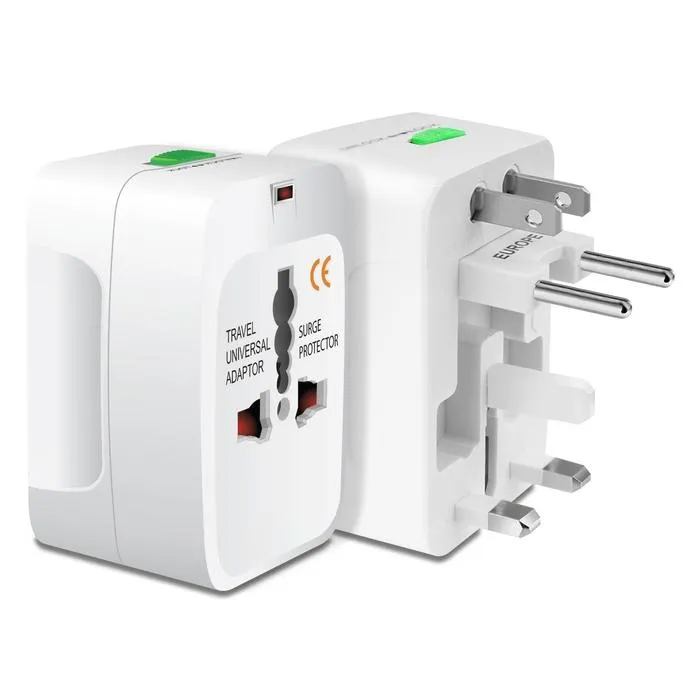
Advantages of planning your trip with us
- Pick-up and drop-off services for all passengers upon international arrival and departure.
- Well-trained, experienced, fluently English-speaking guide, and a strong sherpa or porter for carrying the duffel bag.
- Welcome dinner upon arrival with cultural Nepali dances.
- Three meals a day and tea or coffee during the trek, with accommodation in the mountains.
- First-aid kit box and first-aid services.
- We provide Holiday Planner Nepal’s maps, t-shirt, and cap.
- Down jackets and sleeping bags are available for rent.
- We organize custom services as per the requests of our clients.
- Arrangement of emergency evacuation service (must be paid by the client or insurance).
- We provide an oximeter to check your pulse, oxygen saturation, and heart rate.
- We provide oxygen cans during high-altitude treks.
- We provide SIM cards for travelers, so there won’t be any communication issues.
Conclusion
The Everest Three Pass Trek is the ultimate adventure for trekkers seeking high-altitude challenges, breathtaking Himalayan landscapes, and an immersive Sherpa cultural experience. Crossing Kongma La, Cho La, and Renjo La Passes, exploring Gokyo Lakes, and standing at the base of Mount Everest offers memories that last a lifetime. From the vibrant village of Namche Bazaar to the iconic Kala Patthar viewpoint, every step of this trek reveals the majestic beauty of the Khumbu region.
If you’re ready to embark on this once-in-a-lifetime Himalayan journey, book your Everest Three Pass Trek today with Holiday Tours Nepal and experience the thrill of Nepal’s most spectacular high-altitude adventure!



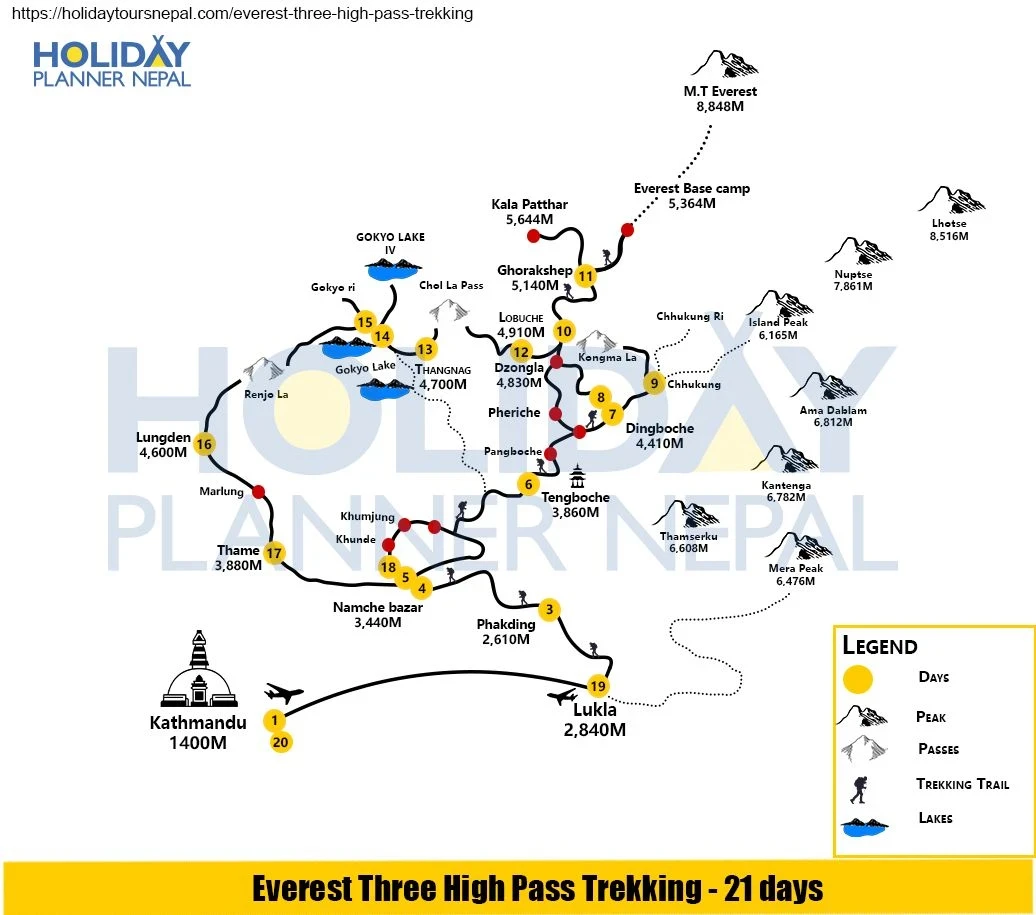


 General
General Upper Body
Upper Body Torso
Torso Lower Body
Lower Body Hands
Hands Feet
Feet Undergarments and Inner Wears
Undergarments and Inner Wears First Aid Kits and Medications
First Aid Kits and Medications Other Essentials
Other Essentials


